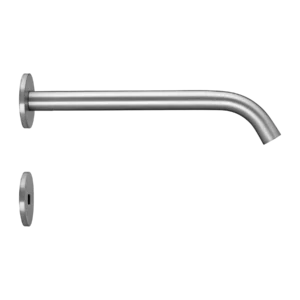Touch-free taps in the washroom are a good idea: they are hygienic, intuitive to use and achieve reliable water savings. Modern 'smart taps' utilise one of two technologies to produce a wave-activated water flow: capacitive sensors or infrared (IR) sensors. To discover which tap technology is suitable for your project, we break down the pros and cons of each to help you decide which hand-washing journey is right for your users.
Capacitive taps
 Capacitance is an electrical charge measured in units called farads. In simple terms, capacitance is the ability to store electrical energy, while capacitors store electrical energy. Almost all things on the planet are capacitors, including the human body, which typically has 22 picofarads of capacitance. This energy is discharged when touching an object at a different voltage potential, which is why we can get a mild electric shock if we've rubbed our feet on carpet then touched a metal doorknob or another person.
When a capacitive sensor is connected to a tap, it turns the entire tap into a sensing device that measures capacitance in its environment. It then uses the energy stored in our bodies to activate the tap. This omni-directional sensing zone around the spout first establishes a baseline level of capacitance before then looking for an increase in capacitance. When a person waves their hand under the tap, it senses an increase and turns on the water flow. When the person's hand moves out of the tap's range, the decrease in capacitance is detected and the tap turns off.
Pros
1. Cleaner aesthetics: there is no visible sensor, so the tap looks sleek and minimal when installed.
2. More intuitive: users don’t have to break a light beam to activate the tap, eliminating 'kung-fu' style hand waving.
3. No light-reflection issues: the tap won't accidentally turn on due to light reflection, as can happen with IR sensors.
Capacitance is an electrical charge measured in units called farads. In simple terms, capacitance is the ability to store electrical energy, while capacitors store electrical energy. Almost all things on the planet are capacitors, including the human body, which typically has 22 picofarads of capacitance. This energy is discharged when touching an object at a different voltage potential, which is why we can get a mild electric shock if we've rubbed our feet on carpet then touched a metal doorknob or another person.
When a capacitive sensor is connected to a tap, it turns the entire tap into a sensing device that measures capacitance in its environment. It then uses the energy stored in our bodies to activate the tap. This omni-directional sensing zone around the spout first establishes a baseline level of capacitance before then looking for an increase in capacitance. When a person waves their hand under the tap, it senses an increase and turns on the water flow. When the person's hand moves out of the tap's range, the decrease in capacitance is detected and the tap turns off.
Pros
1. Cleaner aesthetics: there is no visible sensor, so the tap looks sleek and minimal when installed.
2. More intuitive: users don’t have to break a light beam to activate the tap, eliminating 'kung-fu' style hand waving.
3. No light-reflection issues: the tap won't accidentally turn on due to light reflection, as can happen with IR sensors.
 Infrared technology uses a light beam projected from the sensor to activate water flow. When this light beam hits an object and reflects back, it triggers the switch, which opens the solenoid valve, allowing the water to flow. The active IR sensor has both a transmitter and a receiver for the IR beam. When the beam is emitted from the sensor, no signal is sent to the valve – it is only when the beam is reflected back from an object to the receiver in the sensor that a signal will be sent to the valve to open it and allow water to flow. The solenoid will shut off after a pre-set time to conserve water unless the user’s hands are still within the sensing range of the sensor. In this case, the time delay to close the valve starts when the user’s hands are removed from the detection range.
Pros
1. Power: both mains and battery operation is available.
2. Simple installation: it's quick and easy to install.
Cons
Light-reflection issues: water flow can activate if reflected light hits the IR beam.
Aesthetics: a visible sensor is necessary, which can make the washroom look less minimal.
Click to specify or learn more about our capacitive and IR taps.
Infrared technology uses a light beam projected from the sensor to activate water flow. When this light beam hits an object and reflects back, it triggers the switch, which opens the solenoid valve, allowing the water to flow. The active IR sensor has both a transmitter and a receiver for the IR beam. When the beam is emitted from the sensor, no signal is sent to the valve – it is only when the beam is reflected back from an object to the receiver in the sensor that a signal will be sent to the valve to open it and allow water to flow. The solenoid will shut off after a pre-set time to conserve water unless the user’s hands are still within the sensing range of the sensor. In this case, the time delay to close the valve starts when the user’s hands are removed from the detection range.
Pros
1. Power: both mains and battery operation is available.
2. Simple installation: it's quick and easy to install.
Cons
Light-reflection issues: water flow can activate if reflected light hits the IR beam.
Aesthetics: a visible sensor is necessary, which can make the washroom look less minimal.
Click to specify or learn more about our capacitive and IR taps.
 Capacitance is an electrical charge measured in units called farads. In simple terms, capacitance is the ability to store electrical energy, while capacitors store electrical energy. Almost all things on the planet are capacitors, including the human body, which typically has 22 picofarads of capacitance. This energy is discharged when touching an object at a different voltage potential, which is why we can get a mild electric shock if we've rubbed our feet on carpet then touched a metal doorknob or another person.
When a capacitive sensor is connected to a tap, it turns the entire tap into a sensing device that measures capacitance in its environment. It then uses the energy stored in our bodies to activate the tap. This omni-directional sensing zone around the spout first establishes a baseline level of capacitance before then looking for an increase in capacitance. When a person waves their hand under the tap, it senses an increase and turns on the water flow. When the person's hand moves out of the tap's range, the decrease in capacitance is detected and the tap turns off.
Pros
1. Cleaner aesthetics: there is no visible sensor, so the tap looks sleek and minimal when installed.
2. More intuitive: users don’t have to break a light beam to activate the tap, eliminating 'kung-fu' style hand waving.
3. No light-reflection issues: the tap won't accidentally turn on due to light reflection, as can happen with IR sensors.
Capacitance is an electrical charge measured in units called farads. In simple terms, capacitance is the ability to store electrical energy, while capacitors store electrical energy. Almost all things on the planet are capacitors, including the human body, which typically has 22 picofarads of capacitance. This energy is discharged when touching an object at a different voltage potential, which is why we can get a mild electric shock if we've rubbed our feet on carpet then touched a metal doorknob or another person.
When a capacitive sensor is connected to a tap, it turns the entire tap into a sensing device that measures capacitance in its environment. It then uses the energy stored in our bodies to activate the tap. This omni-directional sensing zone around the spout first establishes a baseline level of capacitance before then looking for an increase in capacitance. When a person waves their hand under the tap, it senses an increase and turns on the water flow. When the person's hand moves out of the tap's range, the decrease in capacitance is detected and the tap turns off.
Pros
1. Cleaner aesthetics: there is no visible sensor, so the tap looks sleek and minimal when installed.
2. More intuitive: users don’t have to break a light beam to activate the tap, eliminating 'kung-fu' style hand waving.
3. No light-reflection issues: the tap won't accidentally turn on due to light reflection, as can happen with IR sensors.
Cons
1. Precise installation is required: a professional should install the tap to ensure it works correctly. 2. Battery operated: it requires a battery for use. IR taps Infrared technology uses a light beam projected from the sensor to activate water flow. When this light beam hits an object and reflects back, it triggers the switch, which opens the solenoid valve, allowing the water to flow. The active IR sensor has both a transmitter and a receiver for the IR beam. When the beam is emitted from the sensor, no signal is sent to the valve – it is only when the beam is reflected back from an object to the receiver in the sensor that a signal will be sent to the valve to open it and allow water to flow. The solenoid will shut off after a pre-set time to conserve water unless the user’s hands are still within the sensing range of the sensor. In this case, the time delay to close the valve starts when the user’s hands are removed from the detection range.
Pros
1. Power: both mains and battery operation is available.
2. Simple installation: it's quick and easy to install.
Cons
Light-reflection issues: water flow can activate if reflected light hits the IR beam.
Aesthetics: a visible sensor is necessary, which can make the washroom look less minimal.
Click to specify or learn more about our capacitive and IR taps.
Infrared technology uses a light beam projected from the sensor to activate water flow. When this light beam hits an object and reflects back, it triggers the switch, which opens the solenoid valve, allowing the water to flow. The active IR sensor has both a transmitter and a receiver for the IR beam. When the beam is emitted from the sensor, no signal is sent to the valve – it is only when the beam is reflected back from an object to the receiver in the sensor that a signal will be sent to the valve to open it and allow water to flow. The solenoid will shut off after a pre-set time to conserve water unless the user’s hands are still within the sensing range of the sensor. In this case, the time delay to close the valve starts when the user’s hands are removed from the detection range.
Pros
1. Power: both mains and battery operation is available.
2. Simple installation: it's quick and easy to install.
Cons
Light-reflection issues: water flow can activate if reflected light hits the IR beam.
Aesthetics: a visible sensor is necessary, which can make the washroom look less minimal.
Click to specify or learn more about our capacitive and IR taps.